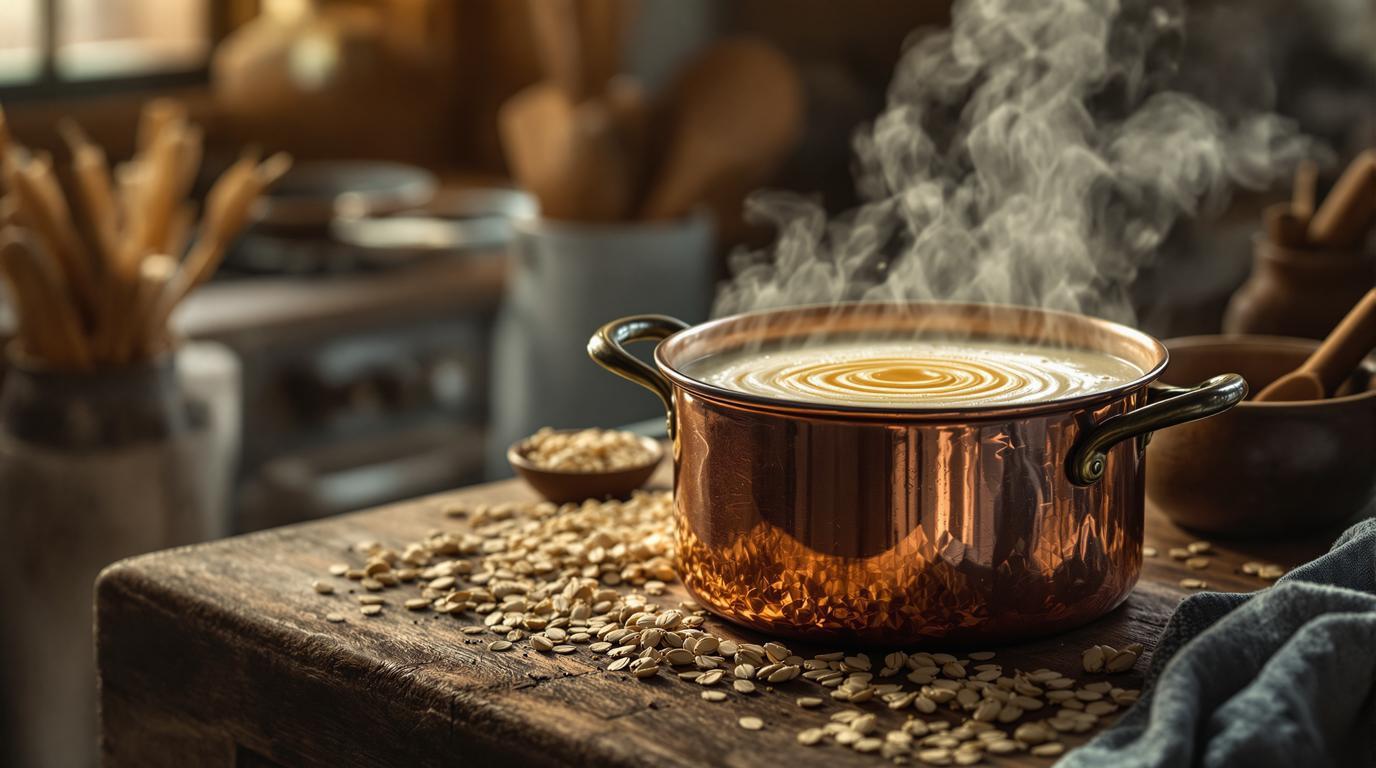There’s something almost sacred about a pot of traditional Scottish porridge simmering on the stove in the early morning hours. The gentle bubbling, the aroma of toasting oats, and the promise of a wholesome breakfast that has sustained generations. During my apprenticeship in Edinburgh, I learned that true Scottish porridge requires just three humble ingredients – ground oats, water, and salt. My mentor, a stern Scotsman named Hamish, would scoff at modern additions, insisting that “porridge needs nothing more than what the earth provides.” Years later, I still hear his voice whenever I prepare this soul-warming dish that has transcended centuries and social classes alike.
The Soul of Scottish Porridge 📖
Long before elaborate breakfast trends, Scottish households relied on this simple yet nourishing porridge to fuel long days of farming and physical labor. What makes traditional Scottish porridge special is its deliberate minimalism – ground oats create a silky texture, water maintains the pure oat flavor, and salt enhances the natural sweetness. While modern adaptations often incorporate milk or cream, the traditional version allows the true character of the oats to shine through. This humble dish sustained the Scottish Highlands through harsh winters and became so integral to Scottish identity that families would keep a dedicated “porridge drawer” where leftover porridge could cool, be sliced, and carried for sustenance throughout the day.
For those interested in exploring other traditional grain preparations, I’ve found this Sicilian olive oil technique remarkably complementary to the Scottish approach – both cuisines celebrate simplicity with profound results.
Essential Ingredients 🧾
Stone-ground oats – 1 cup (90g): The traditional choice offers more texture and nutrition than highly processed varieties. The coarser the grind, the more character your porridge will have. In a pinch, steel-cut or even rolled oats can substitute, though cooking times will vary.
Water – 2½ cups (600ml): Pure, clean water creates the canvas upon which the oat flavor builds. The ratio is important – too little water creates a stodgy texture, while too much results in a thin soup.
Salt – ¼ teaspoon (1g): Don’t skip this crucial ingredient! Salt doesn’t make the porridge taste salty; rather, it enhances the natural sweetness of the oats through contrast. My Scottish mentor would say, “Without salt, porridge tastes like wet newspaper.”
The Sacred Method 📝
- Add your oats to a heavy-bottomed saucepan (this prevents scorching) and toast them over medium heat for 2 minutes until they smell fragrant and nutty.
- Pour in the cold water and add the salt, stirring to combine.
- Bring to a gentle simmer over medium heat, then reduce to low.
- Cook for 15-20 minutes (less for rolled oats, more for stone-ground), stirring frequently with a wooden spoon. The Scots call this stirring implement a “spurtle” – a dedicated porridge-stirring tool.
- The porridge is ready when it thickens to a creamy consistency that slowly drips from your spoon rather than pouring.
Chef’s Note: The direction of stirring was once considered critically important in Scottish tradition. “Clockwise with the right hand” was the rule, as stirring counterclockwise was thought to summon the devil. While I don’t worry about supernatural breakfast guests, I do find that consistent, gentle stirring in one direction creates the silkiest texture.
Traditional Serving Suggestions 🍽️
Authentic Scottish porridge would traditionally be served in a wooden bowl (called a “noggin”) with a small depression in the center. This well would be filled with cream or milk, allowing each spoonful to be dipped for the perfect balance of textures. Modern presentations often include toppings like maple syrup, honey, or fresh berries, though traditionalists might consider these unnecessary embellishments.
For a truly Scottish experience, try a sprinkle of demerara sugar and a splash of whisky on special occasions. The contrast of sweet, smoky and warming is extraordinary. If you’re feeling adventurous, consider serving your porridge alongside this 15-minute hollandaise drizzled over roasted asparagus for a complete breakfast that bridges tradition and innovation.
Beyond Breakfast 🤫
The transformative power of this three-ingredient miracle extends beyond morning meals. Leftover porridge can be cooled, sliced, and pan-fried in butter until golden brown for a traditional Scottish “porridge slice” that pairs beautifully with savory dishes. You might even experiment with porridge as a base for savory grain bowls, much like you would with these dim sum techniques that also celebrate the beauty of simple grains transformed.
After mastering traditional porridge, you might enjoy exploring how these techniques translate to sweet preparations. These classic cream puffs demonstrate a similar transformation of simple ingredients into something magical through technique alone.
Remember, true Scottish porridge isn’t just a dish—it’s a connection to generations past who understood that with quality ingredients and proper technique, even the simplest foods can nurture both body and soul. In our complex culinary world, there’s profound wisdom in returning to these elemental preparations that have sustained humanity for centuries.
